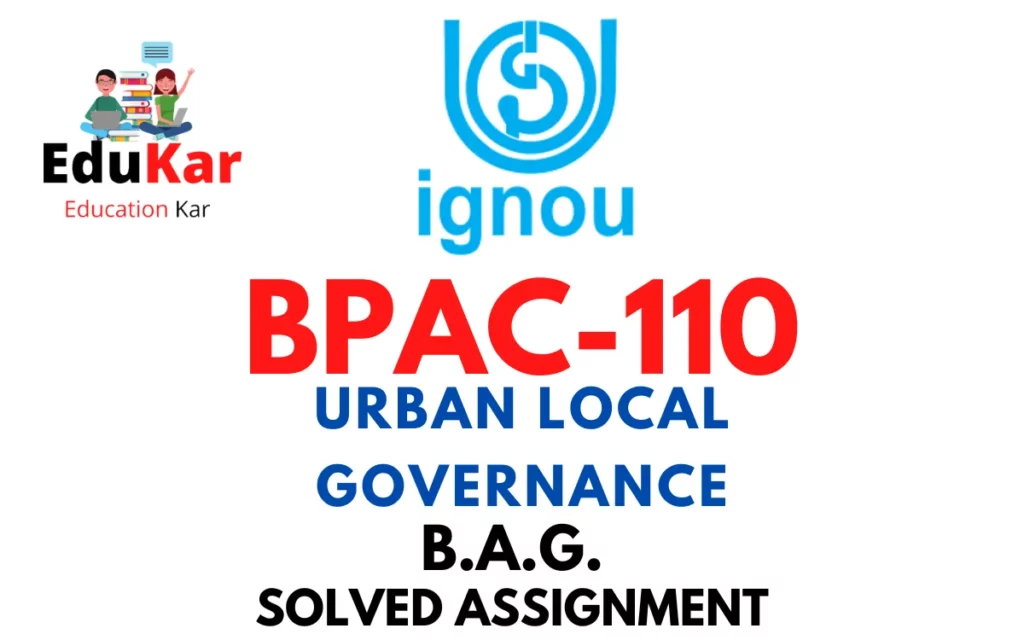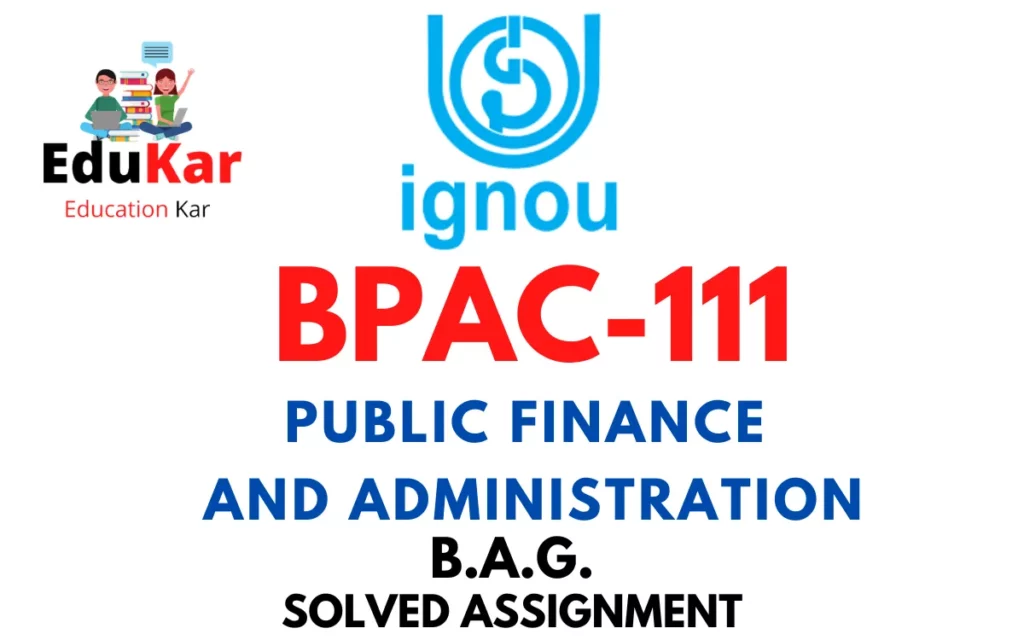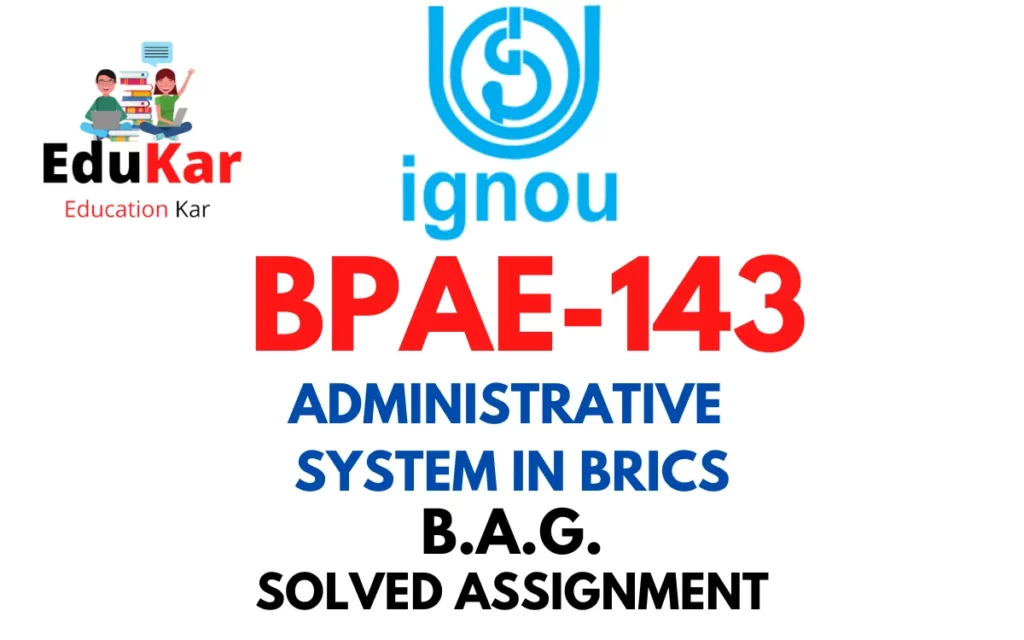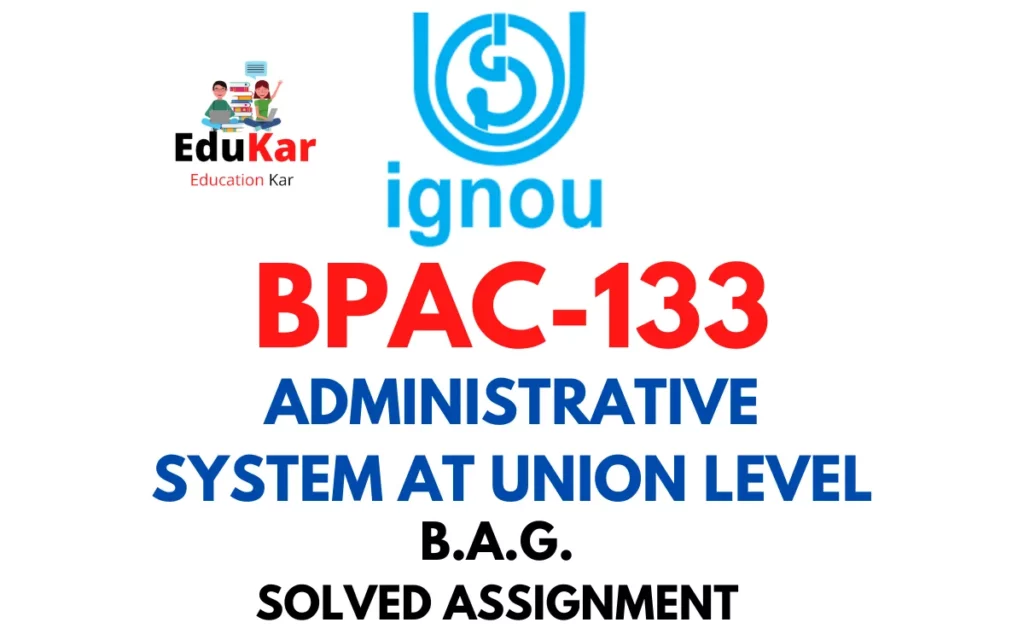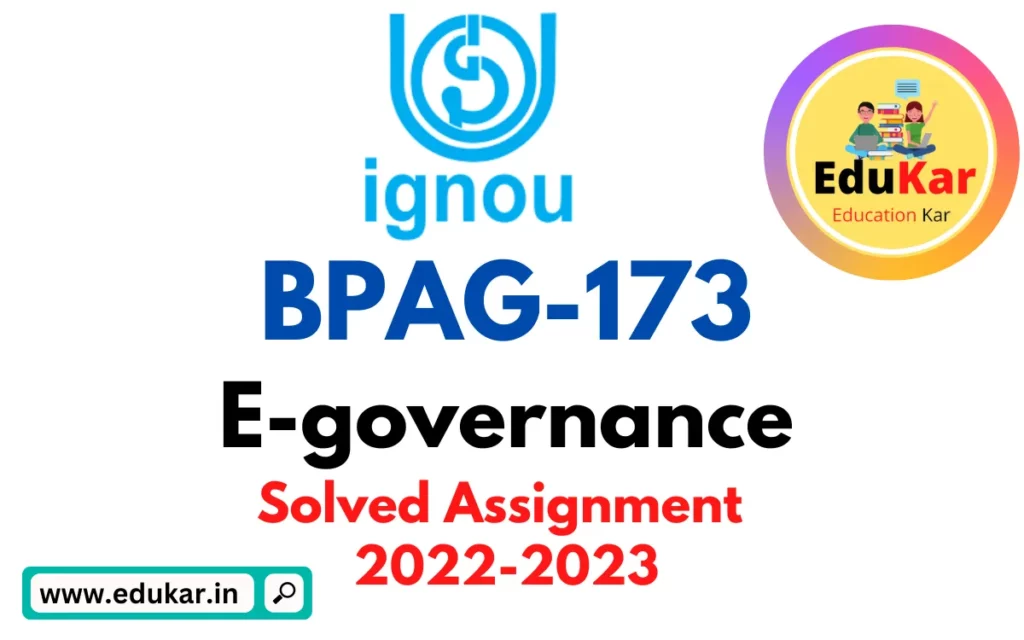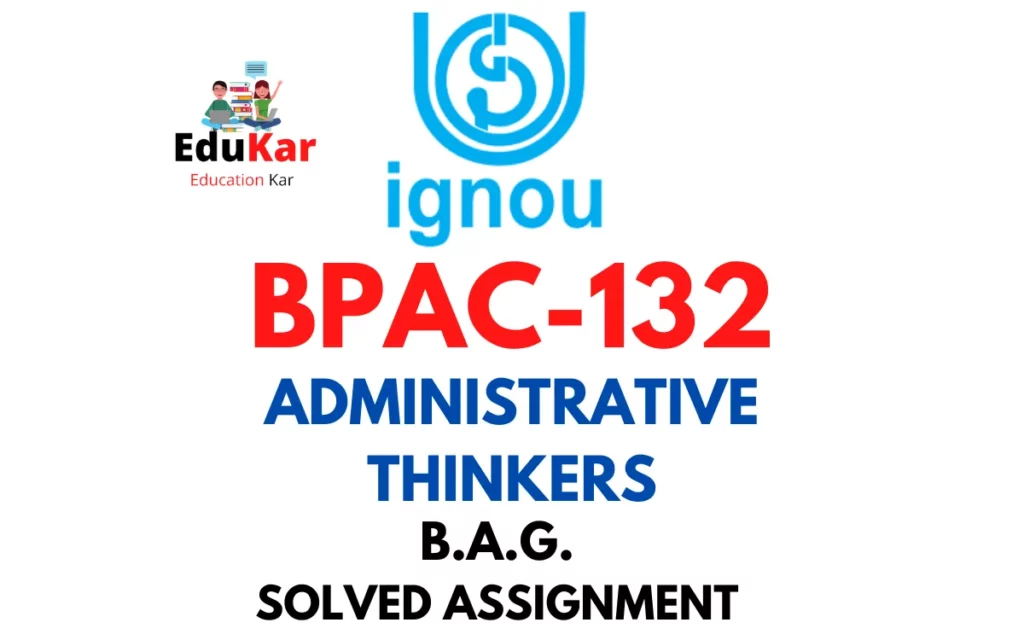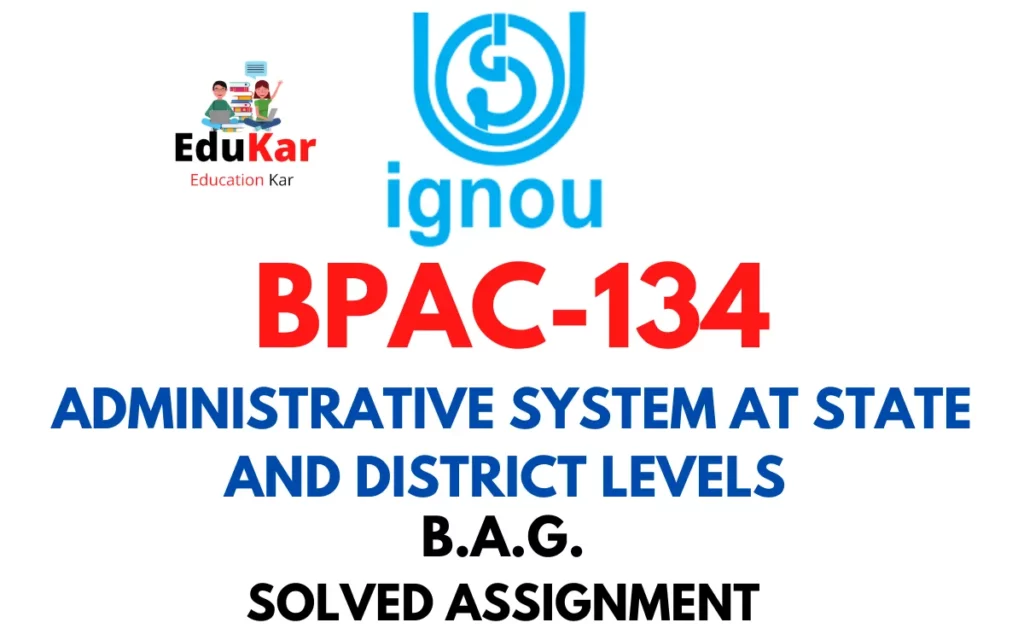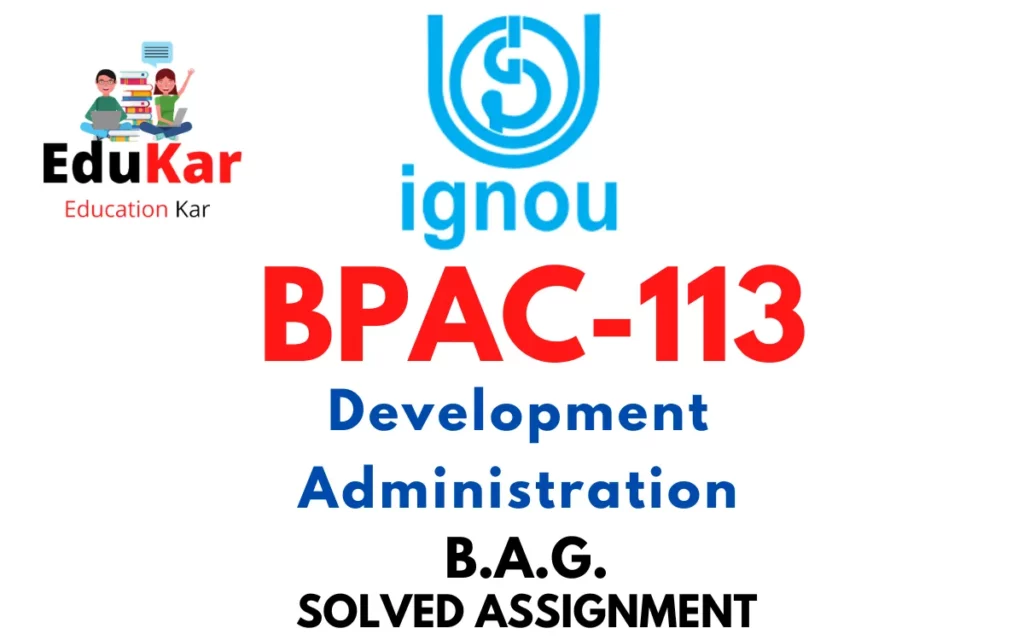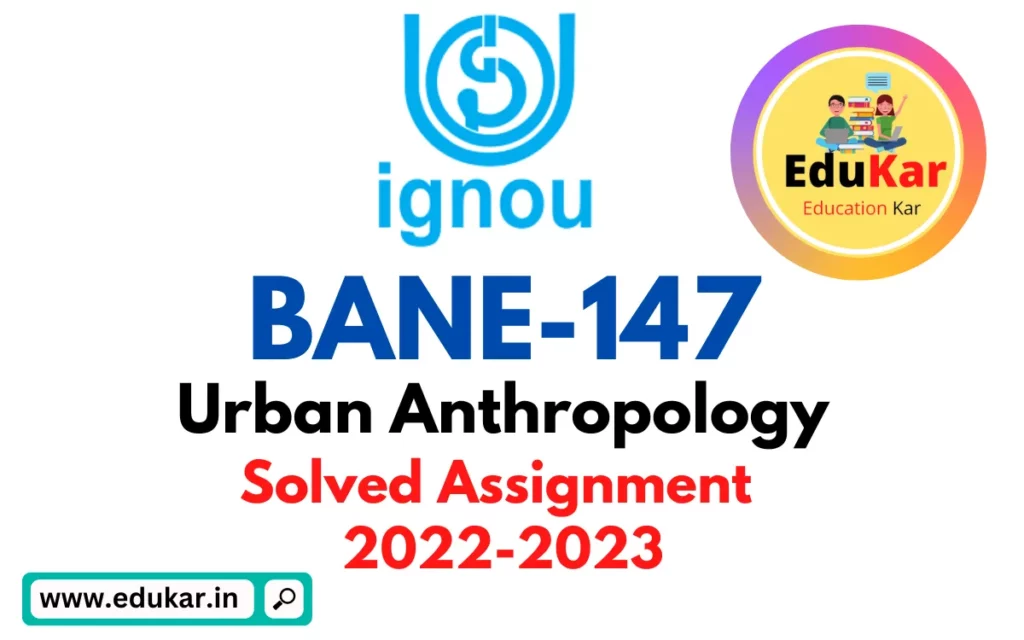Contents
- 1 Assignment A
- 2 Answer the following in about 500 words each.
- 3 1. Discuss the need and significance of decentralised planning foreffective rural local governance.
- 4 2. Examine the approach of the states for democratic decentralisationthrough their statutory provisions.
- 5 Assignment B
- 6 Answer the following questions in about 250 words each.
- 7 3. Analyse the role of State Election Commission in conductingelections at the grassroots level.
- 8 4. Discuss the constitutional provisions of resource mobilsation and management.
- 9 5. What are the major issues and challenges before the PRIs in service delivery?
- 10 Assignment C
- 11 Answer the following questions in about 100 words each.
- 12 6. Discuss the Forest Rights Act, 2006.
- 13 7. Examine the role of District Planning Committee.
- 14 8. Discuss the evolution of local government in pre-independence period.
- 15 9. Enumerate the initiatives of e-Governance in rural India.
- 16 10. Write a note on Jal Jeevan mission.
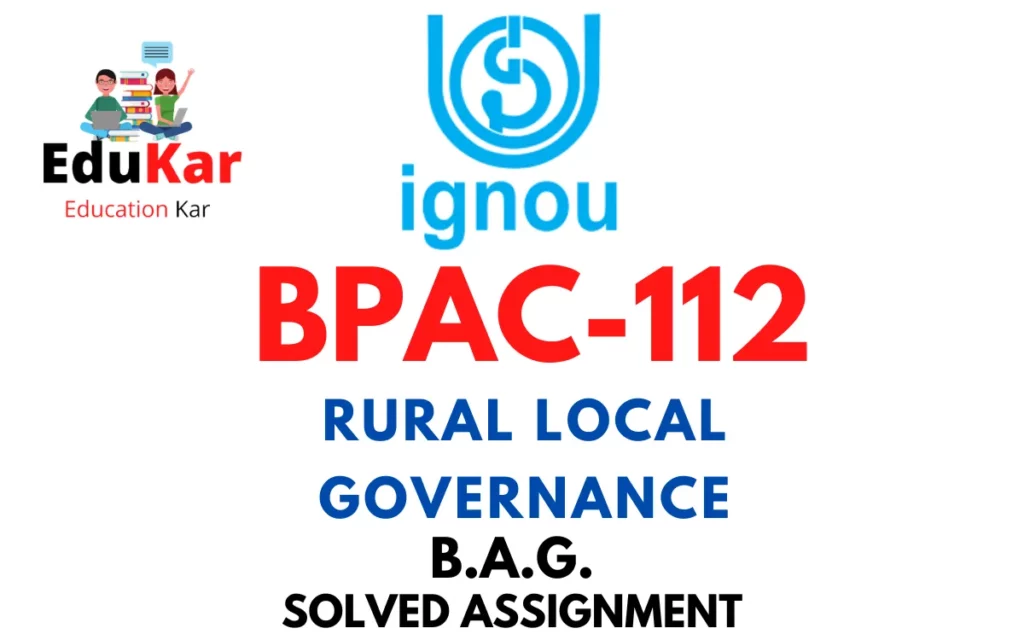
| Title | BPAC-112: IGNOU BAG Solved Assignment 2022-2023 |
| University | IGNOU |
| Degree | Bachelor Degree Programme |
| Course Code | BPAC-112 |
| Course Name | RURAL LOCAL GOVERNANCE |
| Programme Name | Bachelor of Arts (General) |
| Programme Code | BAG |
| Total Marks | 100 |
| Year | 2022-2023 |
| Language | English |
| Assignment Code | ASST/TMA/July 2022 & January 2023 |
| Assignment PDF | Click Here |
| Last Date for Submission of Assignment: | For June Examination: 31st April For December Examination: 30th September |
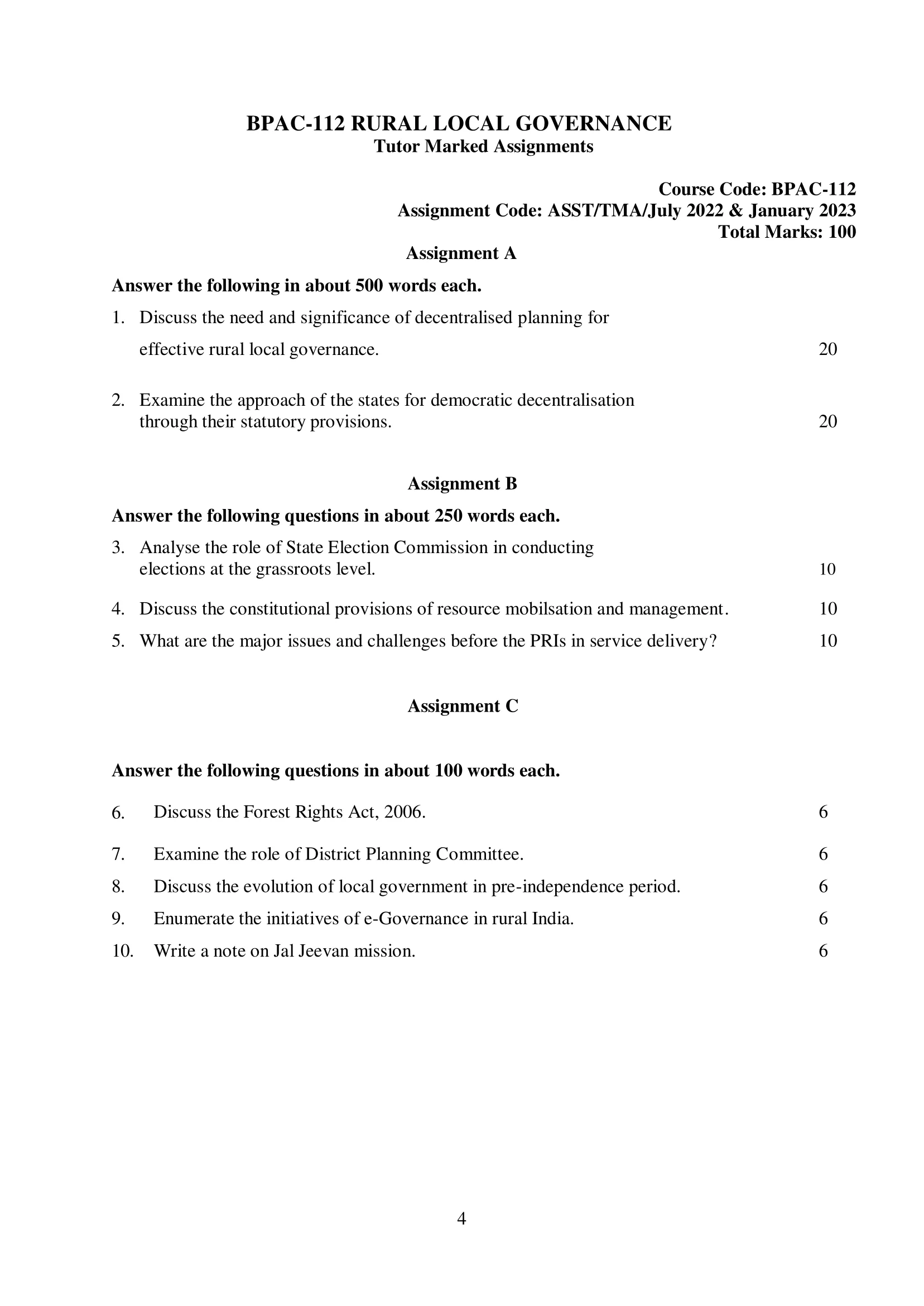
Assignment A
Answer the following in about 500 words each.
1. Discuss the need and significance of decentralised planning for
effective rural local governance.
Ans: Decentralized planning refers to the transfer of power and decision-making authority from the central government to the local level. It is a process of democratizing governance by involving local communities in decision-making and planning processes. In the context of rural development, decentralization is crucial to achieving effective local governance. This is because rural communities face unique challenges that require locally-tailored solutions. In this article, we will discuss the need and significance of decentralized planning for effective rural local governance.
The Need for Decentralized Planning in Rural Areas
- Local Contextualization: Rural communities have unique socio-economic, cultural, and environmental characteristics that require locally-tailored solutions. Centralized planning often fails to account for these differences, resulting in inefficient and ineffective policies.
- Participation and Inclusiveness: Decentralized planning encourages community participation and ensures inclusiveness in the planning process. It provides opportunities for rural communities to voice their needs and priorities, ensuring that their interests are represented in policy formulation.
- Accountability and Transparency: Decentralized planning promotes accountability and transparency in governance. It enables local communities to monitor and evaluate the implementation of policies, ensuring that public funds are used for their intended purposes.
- Empowerment and Capacity Building: Decentralized planning empowers rural communities by building their capacity to participate in governance processes. It provides opportunities for local communities to develop their skills in planning, budgeting, and project implementation.
The Significance of Decentralized Planning in Rural Local Governance
- Local Prioritization: Decentralized planning allows for the prioritization of local needs and priorities. Local communities are better equipped to identify their most pressing issues and develop locally-tailored solutions to address them.
- Resource Allocation: Decentralized planning ensures efficient resource allocation by providing local communities with the flexibility to allocate resources based on their specific needs and priorities.
- Ownership and Sustainability: Decentralized planning ensures local ownership and sustainability of development projects. It provides opportunities for local communities to take ownership of the projects, ensuring that they are sustained beyond the project cycle.
- Innovation and Creativity: Decentralized planning encourages innovation and creativity in addressing local challenges. It provides opportunities for local communities to develop locally-appropriate solutions, resulting in more effective and efficient policies.
- Participation and Inclusiveness: Decentralized planning promotes community participation and inclusiveness in governance. It enables local communities to participate in decision-making and planning processes, ensuring that their voices are heard and their interests are represented in policy formulation.
2. Examine the approach of the states for democratic decentralisation
through their statutory provisions.
Ans: Democratic decentralization is the process of transferring power and decision-making authority from the central government to the local level. In India, democratic decentralization has been facilitated through a range of statutory provisions that empower local governments, such as Panchayati Raj Institutions (PRIs) and Urban Local Bodies (ULBs). In this article, we will examine the approach of states towards democratic decentralization through their statutory provisions.
Panchayati Raj Institutions (PRIs)
Panchayati Raj Institutions (PRIs) are local government bodies at the village, block, and district levels in rural areas. The 73rd Constitutional Amendment Act, 1992, made PRIs a constitutional mandate and empowered them with functions related to local planning, implementation of development programs, and governance.
Approach of States towards PRIs
- Constitutional Provisions: States have enacted laws and rules in compliance with the 73rd Amendment to the Constitution to enable the establishment, composition, and functioning of PRIs. These laws have defined the role and functions of PRIs, established a system of reservation for disadvantaged groups, and provided for their financial resources and capacity building.
- Devolution of Power: States have taken different approaches to the devolution of power to PRIs. Some states have delegated significant functions, including planning and budgeting, to PRIs, while others have not devolved enough power, rendering PRIs ineffective.
- Reservation Policy: States have implemented reservation policies to ensure the representation of women, scheduled castes, and scheduled tribes in PRIs. The proportion of reserved seats varies across states, with some states reserving more than 50% of the seats.
- Financial Resources: States have provided financial resources to PRIs through state finance commissions and other means. Some states have also implemented innovative financing mechanisms, such as the establishment of village development funds and participation in central government schemes.
Urban Local Bodies (ULBs)
Urban Local Bodies (ULBs) are local government bodies that govern urban areas. They are responsible for the provision of basic services such as water supply, sanitation, and solid waste management, and are instrumental in the implementation of central government schemes for urban development.
Approach of States towards ULBs
- Constitutional Provisions: The 74th Constitutional Amendment Act, 1992, made ULBs a constitutional mandate and provided for the establishment, composition, and functions of ULBs. States have enacted laws and rules in compliance with the 74th Amendment to the Constitution to enable the establishment, composition, and functioning of ULBs.
- Devolution of Power: States have devolved varying degrees of power to ULBs. While some states have delegated significant functions, including planning and budgeting, to ULBs, others have not devolved enough power, rendering ULBs ineffective.
- Reservation Policy: States have implemented reservation policies to ensure the representation of women, scheduled castes, and scheduled tribes in ULBs. The proportion of reserved seats varies across states, with some states reserving more than 50% of the seats.
- Financial Resources: States have provided financial resources to ULBs through state finance commissions and other means. Some states have also implemented innovative financing mechanisms, such as the establishment of municipal bonds and participation in central government schemes.
Assignment B
Answer the following questions in about 250 words each.
3. Analyse the role of State Election Commission in conducting
elections at the grassroots level.
Ans: The State Election Commission (SEC) plays a crucial role in conducting elections at the grassroots level in India. The SEC is an autonomous constitutional body that is responsible for supervising and conducting elections to local bodies such as Panchayats and Municipalities in the state. The main role of the SEC is to ensure that elections are conducted in a free, fair, and transparent manner. The following are the key roles of the State Election Commission:
- Conducting elections: The SEC is responsible for conducting elections to the local bodies in the state. It prepares electoral rolls, notifies the election schedule, and conducts the polls.
- Implementation of election code of conduct: The SEC enforces the election code of conduct to ensure that the elections are conducted in a free and fair manner. It ensures that the candidates and political parties follow the rules and regulations laid down by the Election Commission of India.
- Voter education and awareness: The SEC conducts awareness programs to educate the voters about their rights and the election process. It also ensures that the voters are provided with necessary information such as polling booth location, date, and time of polling.
- Complaint redressal: The SEC is responsible for addressing complaints related to the election process. It sets up a grievance redressal mechanism to ensure that the complaints are addressed in a timely and effective manner.
- Certification of election results: The SEC certifies the election results and declares the winners. It also publishes the results on its website and provides the same to the State Government.
4. Discuss the constitutional provisions of resource mobilsation and management.
Ans: The Constitution of India has provisions for resource mobilization and management, which are essential for the functioning of the government and the implementation of various welfare programs. The following are the constitutional provisions related to resource mobilization and management:
- Distribution of taxes: The Constitution of India empowers both the Central and State Governments to levy and collect taxes. The taxes collected are then distributed between the two levels of government according to the principles of federalism.
- Fiscal Responsibility and Budget Management Act (FRBM): The FRBM Act provides guidelines for the government’s fiscal policy, including the preparation and implementation of the Union and State budgets. It lays down the principles of fiscal discipline, transparency, accountability, and long-term sustainability.
- Goods and Services Tax (GST): The GST is a uniform tax levied on the supply of goods and services across the country. It replaced multiple taxes levied by the Central and State Governments, leading to a more efficient and streamlined tax regime.
- Borrowing: The Constitution of India allows the Central and State Governments to borrow money from the market to finance their expenditure. However, there are certain limits and guidelines for borrowing to maintain fiscal discipline.
- Grants-in-aid: The Central Government provides grants-in-aid to the State Governments for specific purposes such as education, health, and infrastructure development. These grants-in-aid are aimed at bridging the resource gap between the Central and State Governments.
- Public Accounts: The Constitution of India provides for the maintenance of public accounts for each State and the Union. The accounts contain the receipts and expenditure of the government, including loans and grants.
- Comptroller and Auditor General (CAG): The CAG is an independent constitutional authority responsible for auditing the accounts of the Central and State Governments. It ensures the proper utilization of public funds and promotes transparency and accountability in financial management.
5. What are the major issues and challenges before the PRIs in service delivery?
Ans: The Panchayati Raj Institutions (PRIs) are the local governing bodies in India, responsible for the administration of rural areas. The PRIs were established to ensure the participation of local communities in decision-making processes, promote local-level democracy, and provide basic services to the people. However, there are several issues and challenges before the PRIs in service delivery, which are discussed below:
- Inadequate financial resources: PRIs are dependent on the Central and State Governments for financial resources, which are often insufficient for delivering basic services to the people. This results in a lack of funds for infrastructure development, health, education, and other services.
- Limited capacity: The members of PRIs are often ill-equipped to carry out their responsibilities, particularly in terms of technical expertise and financial management. This lack of capacity is a major challenge in effective service delivery.
- Ineffective planning: In many cases, the planning of PRIs is not aligned with the needs and priorities of the local communities. This results in inadequate and ineffective service delivery.
- Lack of public participation: PRIs were established to encourage public participation in decision-making. However, in many cases, there is a lack of participation from the public, which results in ineffective service delivery.
- Corruption: Corruption is a major issue that affects service delivery by PRIs. The lack of transparency and accountability in the functioning of PRIs is a significant challenge in ensuring effective service delivery.
- Inadequate monitoring and evaluation: There is a lack of effective monitoring and evaluation systems in place to measure the performance of PRIs in service delivery. This results in a lack of accountability and transparency, which negatively affects service delivery.
Assignment C
Answer the following questions in about 100 words each.
6. Discuss the Forest Rights Act, 2006.
Ans: The Forest Rights Act, 2006 is a landmark legislation that provides for the recognition and vesting of forest rights and occupation in forestland to forest-dwelling communities. The Act recognizes the rights of forest-dwelling communities to use, protect, and manage forests for their livelihood and other traditional needs. It also seeks to address historical injustices and to ensure that the rights of forest-dwelling communities are protected. The Act empowers the Gram Sabha to initiate the process of recognizing and vesting forest rights and provides for the setting up of committees to facilitate the recognition and vesting of forest rights. The Forest Rights Act, 2006, is a significant step towards recognizing the rights of forest-dwelling communities and ensuring the sustainable use and management of forest resources.
7. Examine the role of District Planning Committee.
Ans: The District Planning Committee (DPC) is a constitutional body that plays a crucial role in decentralised planning and local governance in India. The DPC was established under the 73rd and 74th Constitutional Amendments in 1992 and is mandated to prepare and consolidate the district plans for economic development and social justice.
The primary role of the DPC is to prepare and approve a draft development plan for the district. This plan is then forwarded to the state planning board for inclusion in the state plan. The DPC also monitors the implementation of the district plan and has the power to make changes and adjustments to the plan based on feedback from the Gram Sabhas and other stakeholders.
The DPC is chaired by the district collector and includes members from the local self-government bodies, such as the Zilla Parishad, Municipal Councils, and Gram Panchayats, as well as representatives from the community-based organizations, non-governmental organizations, and other stakeholders. The DPC is responsible for facilitating the participatory planning process by ensuring that the views and suggestions of the Gram Sabhas and other stakeholders are taken into account during the planning process.
The DPC also plays a critical role in ensuring social justice and equity in the district plan by identifying the needs of the marginalized and disadvantaged sections of society and incorporating measures to address their needs. The DPC is also responsible for identifying and prioritizing the schemes and programs to be implemented in the district, based on the development priorities and the availability of resources.
8. Discuss the evolution of local government in pre-independence period.
Ans: The evolution of local government in India can be traced back to the pre-independence period, where local bodies were created to ensure better administration and governance of rural areas. The following are some of the key stages in the evolution of local government in pre-independence India:
- Village Panchayats: Village panchayats were the earliest form of local government in India, which were established to ensure the administration of villages. The panchayats were responsible for settling disputes, providing public services, and maintaining law and order in the village.
- District Boards: District boards were established in the 19th century to provide better governance of rural areas. These boards were responsible for the construction of roads and bridges, water supply, and sanitation, among other functions.
- Municipalities: Municipalities were established in urban areas to provide better governance of cities and towns. The first municipality was established in Madras (now Chennai) in 1687. Municipalities were responsible for providing public services such as water supply, sanitation, and street lighting.
- Provincial Legislatures: Provincial legislatures were established in the early 20th century, which gave greater representation to Indians in the legislative process. These legislatures were responsible for law-making and governance of the provinces.
- Dyarchy: The Montagu-Chelmsford Reforms of 1919 introduced the concept of dyarchy, which divided the administration of the provinces into two parts – transferred and reserved. The transferred subjects were under the control of Indian ministers, while the reserved subjects were under the control of British ministers.
9. Enumerate the initiatives of e-Governance in rural India.
Ans: Several initiatives have been undertaken by the Indian government to promote e-Governance in rural India. The following are some of the key initiatives:
- Common Service Centres (CSCs): CSCs have been established across rural India, which act as access points for delivery of various government and private services. These CSCs provide services such as digital literacy, Aadhaar enrolment, passport application, and banking services, among others.
- Digital India Programme: The Digital India Programme aims to transform India into a digitally empowered society and knowledge economy. The programme has various components such as the National Optical Fibre Network (NOFN), which aims to provide high-speed internet connectivity to all gram panchayats in the country.
- National e-Governance Plan (NeGP): The NeGP is a comprehensive framework for delivering government services to the citizens through electronic means. It has various components such as e-District, which provides services such as issuance of certificates, licenses, and permits, and e-Panchayat, which aims to strengthen the functioning of Panchayati Raj Institutions (PRIs) through the use of technology.
- BharatNet: BharatNet aims to connect all villages in the country with high-speed broadband connectivity. The project aims to provide affordable and reliable internet connectivity to rural households and promote digital literacy.
- Mobile Governance: Mobile Governance aims to deliver government services through mobile devices. The initiative aims to provide services such as agricultural information, health information, and weather updates to rural citizens through their mobile phones.
10. Write a note on Jal Jeevan mission.
Ans: Jal Jeevan Mission is a flagship programme of the Indian government, launched in 2019, with the aim of providing piped water supply to all households in rural India by 2024. The mission aims to provide safe and adequate drinking water to every household, along with promoting the use of water conservation and management practices. The Jal Jeevan Mission seeks to create a Jan Andolan, or people’s movement, for water, where communities come together to manage their water resources and ensure its sustainability. The programme also aims to improve the lives of women and girls, who are the primary water collectors in rural households, by reducing their drudgery and improving their health and hygiene.
How to Download BPAC-112 Solved Assignment?
You can download it from the www.edukar.in, they have a big database for all the IGNOU solved assignments.
Is the BPAC-112 Solved Assignment Free?
Yes this is absolutely free to download the solved assignment from www.edukar.in
What is the last submission date for BPAC-112 Solved Assignment?
For June Examination: 31st April, For December Examination: 30th October

